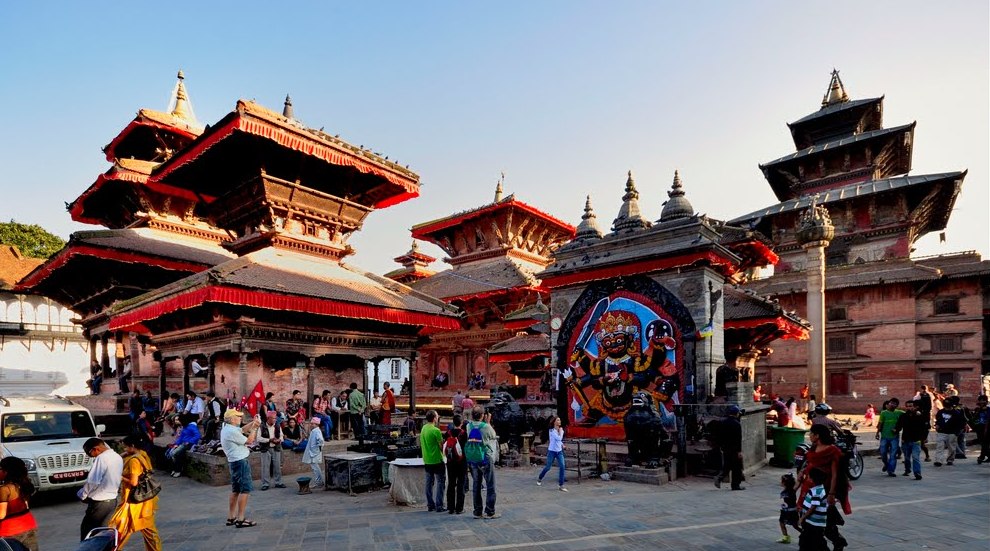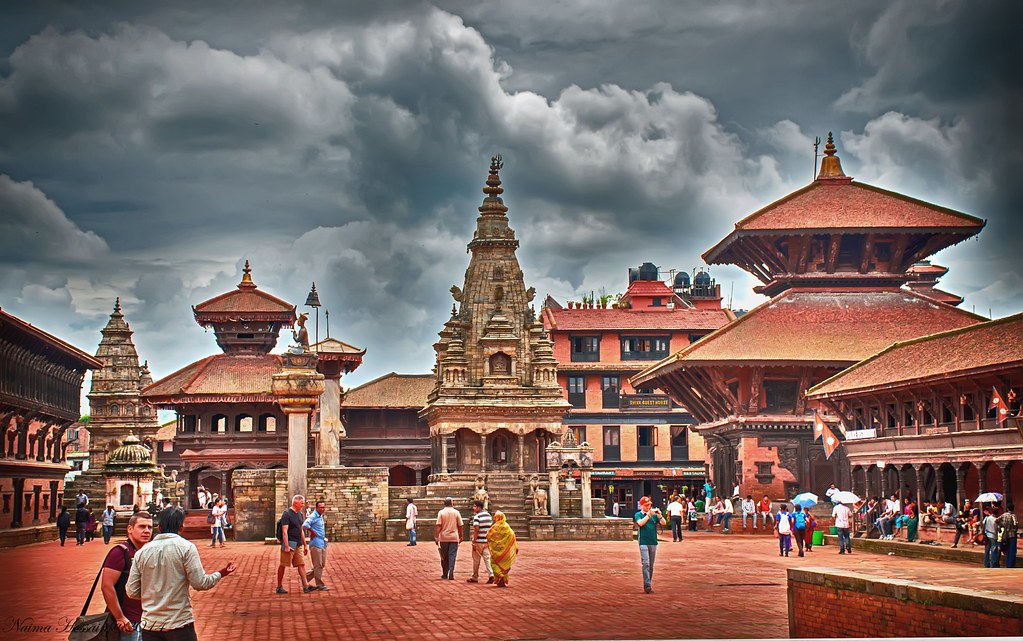History Behind 3 Durbar Squares of Kathmandu
Durbar Square refers to the places near Nepal’s Royal Palaces of the past. Temples, idols, statues, open courts and fountains along with other structures form part of Durbar Square. In the past Durbar Squares had been witness to events of importance including coronation of kings of the land. Now united as one country, Nepal was once a land that consisted many small kingdoms. Durbar Squares are fine examples of the life and style of the ancient kingdom. The famous three Durbar Squares in Nepal are Kathmandu Durbar Square, Patan Durbar Square and Bhaktapur Durbar Square. UNESCO has declared these squares as World Heritage Sites.
 Kathmandu Durbar Square is one of the important historic and tourist destinations in Nepal. It is also famously called as Basantapur Durbar Square and Hanuman Dhoka Durbar Square. This spectacular Durbar Square reflects the artistry that prevailed in the past. Kathmandu Durbar Square houses palaces and ancient temples that belong to the periods between 12th and 18th centuries. Kathmandu Durbar Square lies in the heart of ancient city in Kathmandu. Locally also called as Hanuman Dhoka. It is one of three Durbar (Royal Palace) squares in the Kathmandu Valley in Nepal, all of which are "UNESCO World Heritage Site." It is a cluster of ancient temples, palaces, courtyards and streets that date back to the 12th and the 18th centuries. The square is known to be the social religious and urban focal points of the capital city. It consists of two divisions, which are referred to as outer complex and inner complex. The outer complex has famous temples namely Taleju Temple, Jagannath Temple, Shiv-Parvati Temple, Big Bell and Kumari Bahal. The inner complex has old palace, courtyards, Basantapur Durbar, Hanuman Dhoka and other structures. The palace in the complex was the residence of the Nepalese Royal family until 19th century and coronation of kings took place here. The temples representing Hindu and Buddhist faiths are constructed in pagoda style. The stunning architecture involved in the construction of temples and palaces in Kathmandu Durbar Square makes the place one of the most frequented tourist destinations.
Kathmandu Durbar Square is one of the important historic and tourist destinations in Nepal. It is also famously called as Basantapur Durbar Square and Hanuman Dhoka Durbar Square. This spectacular Durbar Square reflects the artistry that prevailed in the past. Kathmandu Durbar Square houses palaces and ancient temples that belong to the periods between 12th and 18th centuries. Kathmandu Durbar Square lies in the heart of ancient city in Kathmandu. Locally also called as Hanuman Dhoka. It is one of three Durbar (Royal Palace) squares in the Kathmandu Valley in Nepal, all of which are "UNESCO World Heritage Site." It is a cluster of ancient temples, palaces, courtyards and streets that date back to the 12th and the 18th centuries. The square is known to be the social religious and urban focal points of the capital city. It consists of two divisions, which are referred to as outer complex and inner complex. The outer complex has famous temples namely Taleju Temple, Jagannath Temple, Shiv-Parvati Temple, Big Bell and Kumari Bahal. The inner complex has old palace, courtyards, Basantapur Durbar, Hanuman Dhoka and other structures. The palace in the complex was the residence of the Nepalese Royal family until 19th century and coronation of kings took place here. The temples representing Hindu and Buddhist faiths are constructed in pagoda style. The stunning architecture involved in the construction of temples and palaces in Kathmandu Durbar Square makes the place one of the most frequented tourist destinations.
The Taleju Temple: The square’s most magnificent temple stands at its northeastern extremity but is not open to the public. Even for Hindus admission is restricted; they can only visit it briefly during the annual Dasain festival. Taleju Temple is the tallest of all structures, built by King Mahendra Malla in 1549 AD. The temple is a famous Hindu and Jain religious site.
The Jagannath Temple: built in the 16th century. The Jagannath Temple is recognized as the finest of the group near Hanuman Dhoka. Exquisite wood-carvings embellish the doors, windows and roof struts, depicting a panoply of gods from the Hindu pantheon. Originally dedicated to Vishnu the shrine was later re-dedicated to Jagannath.
Mahendreshvara Temple: The simple yet beautiful temple was built by King Mahendra Malla and is dedicated to the Hindu Lord Shiva in the form of Pashupati. The temple was destroyed in a 1934 earthquake and rebuilt thereafter. The temple is a memorial to its founder.
Hanuman Dhoka: is the main attraction in the area and also serves as museum. Though believed to be built in Licchari periods, most of the remaining part was built by king Pratap Malla in 17th century. Palace facade turns at right angles between the Degutale Temple and the Taleju Mandir. This way is created Hanuman Dhoka (Hanuman is a monkey god). Hanuman idol placed in the dhoka has been anointed with mustard oil and vermilion through the centuries.
Shiva Temple: It is one of the famous temples in Kathmandu Square Durbar. Dedicated to Shiva and Parvati, the temple is believed to be reconstructed later. The Shiva Temple in Darbar Square is a replica of the Jaisi Deval and was built by Riddhi Lakshmi in 1690.
Kumari Bahal: Kumari Bahal is the abode of Living Goddess. Built in the year 1757, it resembles a monastery. A girl chosen to be living goddess of the town lives in the place until she reaches puberty after which she returns to her normal life.
Kasthamandapa: Kasthamandap or house of wood is the building which gave Kathmandu its name. Legend narrates that the whole building is constructed from a Single Sal tree. At first it was a community hall where local people gathered for important ceremonies but later it was converted to a Temple of Gorakhnath. The image of Gorakhnath glitters at the center of the building.
Bhandarkal: Bhandarkal is yet another attraction in Kathmandu Durbar Square. It is a botanical garden established by King Pratap Mall during 17th century. The garden earns its name after a palace that houses the statue of Jalashayana Narayan, the Sleeping Vishnu. With wide range of fauna, Bhandarkal is haven for nature lovers.
 Patan Durbar Square Patan, also known as Lalitpur, is located on the south of Bagmati River and it is one amongst the three royal cities in Kathmandu valley. It is also the oldest among the three cities. Patan Durbar Square has been declared as World Heritage Site by UNESCO. Famous for its rich cultural heritage, Patan is home to fine arts. The splendid woodcarvings and metal statues speak stories of the skills of artisans. Considered to be established during the 3rd century BC, Patan is a cultural center where many festivals are celebrated every year. Four Ashoka Stupas built in four cardinal points of Patan are considered very important architectural treasures of the land. The Stupas are said to be built by Emperor Ashoka during 250 BC. Temples, palaces, statues and stone baths are some of the constructions found in Patan Durbar Square. Given below are some of the famous places in Patan Durbar Square.
Patan Durbar Square Patan, also known as Lalitpur, is located on the south of Bagmati River and it is one amongst the three royal cities in Kathmandu valley. It is also the oldest among the three cities. Patan Durbar Square has been declared as World Heritage Site by UNESCO. Famous for its rich cultural heritage, Patan is home to fine arts. The splendid woodcarvings and metal statues speak stories of the skills of artisans. Considered to be established during the 3rd century BC, Patan is a cultural center where many festivals are celebrated every year. Four Ashoka Stupas built in four cardinal points of Patan are considered very important architectural treasures of the land. The Stupas are said to be built by Emperor Ashoka during 250 BC. Temples, palaces, statues and stone baths are some of the constructions found in Patan Durbar Square. Given below are some of the famous places in Patan Durbar Square.
Major Attractions In Patan Durbar:
Patan Museum: Patan Museum ranks among the best museums in the Asian continent. The museum is situated in an ancient palace, which dates back to 1734. The collections in the museum depict the rich cultural history of Nepal. Most of the collections are bronze statues and gilt copper objects. The garden adjacent to the museum offers a pleasant sight and a peaceful resting place.
Godavari Botanical Garden: Godavari Botanical Garden is situated on the southern side of Patan Durbar Square. The garden has a wide range of plants and the dense forest offers great scope for bird watching and hiking. It is also a famous picnic spot.
Kumbeshwor Temple: Kumbeshwor Temple is one among the two 5-tier temples in Nepal. It is dedicated to Lord Shiva. The temple dates back to 1391 and it was initially a two-tiered construction. The natural spring inside the temple is considered to come from the famous Gosainkunda Lake.
Bhaktapur Durbar Square presents a combination of pagoda and shikhara style of temples. The place is an architect’s delight as it is a fine specimen of sculptures and woodcarvings. The temples are located around the fifty-five window palace made of brick and wood. Bhaktapur Durbar Museum represents the traditional art of Nepal. The ancient city engages you with a fine display of magnificent local products, pottery, and various other artworks apart from the beautiful temples. Some of the most important places in Bhaktapur Durbar Square are:
55 Window Palace: Dating back to 15th century AD, 55 Window Palace is a marvelous construction that displays architectural splendor in a very fine form. It was built by King Yakshay Malla and later was renovated by King Bhupatindra Malla during 17th century. The palace derives its name from the unique construction of 55 windows in a balcony, which is a fine example of woodcarving.
Major Attraction In Bhaktapur Durbar Square:
The Golden Gate: The main entrance to the courtyard of ancient palace of 55 Windows, Golden Gate, is an awe-inspiring specimen of architectural excellence. King Ranjit Malla erected the Golden Gate, which is embellished with mythical creatures.
The Lion Gate: The Lion Gate was erected in 1696 AD. It has two big-sized lion statues on either side. The statues of Lord Shiva and Ugrachandi are compelling attractions of the gate. It is believed that Bhadgaon King cut off artisans’ hands after they completed the artwork to ensure that such work is not repeated elsewhere.
The Art Gallery: The Art Gallery houses ancient paintings representing the faiths of Hinduism and Buddhism. The gallery is frequented by researchers of these faiths to obtain an insight into the traditions that prevailed in the past.
All the three famous Durbar Squares give you an insight into the life and style of the ancient kingdom. The well-constructed temples and other structures display the artistic minds behind such delivery. Touring these parts of Kathmandu is sure to delight you and elevate your spirits several planes higher. These places are not just feast to your eyes; they take you further to enjoy the essence of the cultural heritage of the land.

